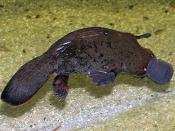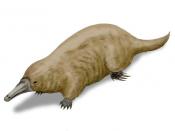The Platypus was first described in 1799 in Shaw's naturalist's Miscellany along with the koala, Kangaroo, wombat and emu. The most curious was the platypus. Since its first discovery there has been much debate as to whether it is a mammal and how it should be classified.
The platypus is a primitive mammal that has many features that separate it from other mammals-it lays eggs, there is an absence of true teeth and an absence of mammary glands, although it has special glands that secrete milk. It has fur like other animals, but it has a beak like the bill of a duck, webbed feet and a tail like a beaver.
A dried platypus skin has been sent to England in 1798 and was considered to be fake.
Up until 1884 there was uncertainty about how the platypus reproduced. In 1884 Caldwell solved the problem by capturing a female with eggs.
About 1904 the scientific American reported that there are many mammals that do not possess teeth when adults.
Up until 1973 there was uncertainty about the platypus being able to regulate its body temperature like other mammals. Recent research shows that it can regulate body temperature but the mechanism is underdeveloped.
There are two living groups: The platypuses and the echidnas. The only Cretaceous mammal known for Australia is also a monotreme, Steropodon galmani, a platypus-like animal that might be more appropriately placed in a family of its own.
Until 1971, an understanding of the history of Australia's platypus was non-existent. Apart from the fact that it was a monotreme and only known from Australia, all else was mystery. Then three major discoveries were made: two molar teeth of Obdurodon insignis, a 25 million-year-old platypus from the Tirari desert; a jaw fragment with three teeth of sterepodan...



Is platypus mammal
Essay is quite good & informative.
1 out of 1 people found this comment useful.